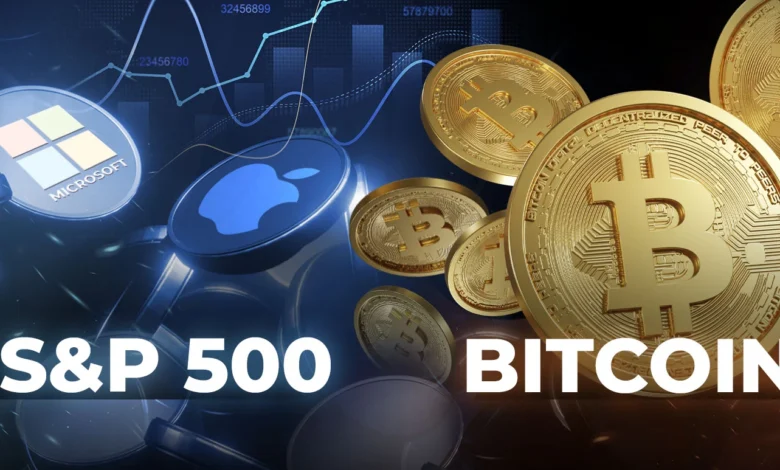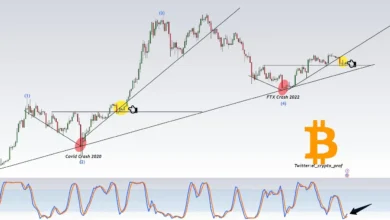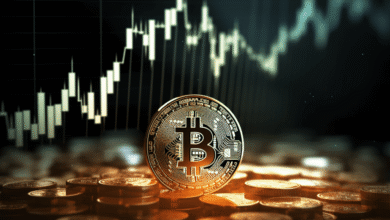
Bitcoin Drops Below $108K as S&P 500 Surges in 2025 Markets
On June 12, the financial world witnessed an interesting divergence between Cryptocurrency Markets and traditional stocks. Bitcoin Drops, the most popular digital asset, fell below the psychologically critical level of $108,000. The S&P 500 index (SPX), on the other hand, rose sharply, making it the biggest gainer among all worldwide markets today.
This difference highlights the challenge investors face in striking a balance between highly volatile cryptocurrencies and more stable stock market products. This essay examines the reasons behind Bitcoin Drops recent price drop, the factors contributing to the SPX’s rise, and what these events signify for the financial markets in mid-2025.
Bitcoin’s Volatility Amid Macroeconomic and Regulatory Shifts
Bitcoin’s price hit a wall and faced selling pressure after a time of substantial rises due to more institutions using it, more people being interested in it, and positive feelings about blockchain advancements. The drop indicates that Bitcoin remains highly volatile, despite the market becoming more stable.
Several macroeconomic factors are responsible for this decline. The Federal Reserve’s recent hints about future interest rate changes have made risk assets around the world less predictable. When interest rates rise, it becomes more challenging for individuals to buy and sell assets in the financial markets. This makes people less inclined to invest in risky ventures, such as cryptocurrency. Additionally, concerns about inflation in the U.S. and other economies have prompted investors to reassess risk and reallocate their investments, which sometimes involves selling digital assets.

Changes in regulations are also quite significant. Over the last several weeks, the U.S. Securities and Exchange Commission (SEC) has been paying closer attention to major crypto exchanges and decentralised finance (DeFi) protocols. People are selling in the short term because they believe tighter rules are forthcoming. China and India are still cautious about cryptocurrencies, but the European Union and other regions are moving forward with plans to regulate them more thoroughly. These factors, combined, have made things even more unpredictable, leading to a drop in Bitcoin’s price.
S&P 500 Rally Driven by Strong Earnings and Economic Confidence
The S&P 500 index, on the other hand, went up, making it the best-performing index of the day. The SPX’s rise is based on strong earnings announcements from major companies across various sectors, including technology, healthcare, and consumer discretionary. Apple, Microsoft, and Amazon are among the companies that have announced revenue growth exceeding projections. This demonstrates their ability to address global economic challenges.
Encouraging macroeconomic data has also helped boost investor confidence in the stock market. The U.S. Bureau of Economic Analysis has recently reported that the GDP is growing steadily and that unemployment remains very low. People are hopeful that the U.S. economy will continue to grow due to these two factors.
The Federal Reserve’s careful approach to communicating with the public has made market sentiment even more stable. The Fed has reassured investors by stating that monetary policy choices should be based on data and warning against significant rate hikes. This has helped maintain high liquidity and risk tolerance in the stock markets, leading to capital inflows that differ from the cautious approach seen in cryptocurrencies.
Institutional Influence and Market Dynamics Linking Crypto
Bitcoin was once viewed as a hedge that had nothing to do with regular financial markets, but recent market behaviour has made this distinction less clear. Cryptocurrencies have moved in the same direction as stocks at times when more institutions have gotten involved, especially when there is less risk or money is tight.
The overlapping investor base and the expanding use of crypto assets in diverse portfolios managed by hedge funds, family offices, and institutional investors help to explain this situation. When there are more macroeconomic or geopolitical difficulties, these investors often adjust the balance of their holdings, which affects both asset classes simultaneously.
Geopolitical events, such as trade talks between the U.S. and China or wars that impact global supply chains, continue to influence market volatility. These changes have an impact on both traditional markets and the cryptocurrency sector, which relies significantly on digital infrastructure and the global investor sentiment.
Bitcoin’s Technological Advances and Regulatory Developments
Bitcoin’s usefulness and transaction speed continue to improve thanks to protocol updates that enhance scalability and privacy protection. The Lightning Network, which was developed to facilitate faster and cheaper transactions, is gaining popularity. It is expected to strengthen Bitcoin’s role as a means of trade, rather than merely a store of value.

At the same time, it remains crucial to have clear rules in place. Countries worldwide are attempting to devise regulations for cryptocurrencies that strike a balance between innovation and regulation. The SEC’s judgments on Bitcoin Price ETFs and the EU’s Markets in Crypto-Assets (MiCA) rules are significant steps forward.
Final thoughts
Investors should closely monitor both technical and fundamental indicators in the future. Critical support levels for Bitcoin are about $105,000, while essential resistance levels are around $110,000. These levels will likely determine short-term market patterns. Macro factors, such as U.S. inflation data, Federal Reserve pronouncements, and shifts in the geopolitical landscape, continue to be significant in shaping people’s perceptions of the market.
For stock investors, keeping an eye on earnings season and economic reports will be crucial in determining how long the S&P 500’s rise lasts. Additionally, the state of global trade and the supply chain will impact the direction of the market. In 2025, it will be crucial to manage risk wisely and diversify your investments across various asset types. This is because cryptocurrencies and traditional markets will interact in complex ways.







